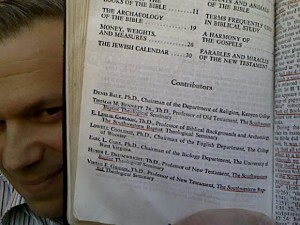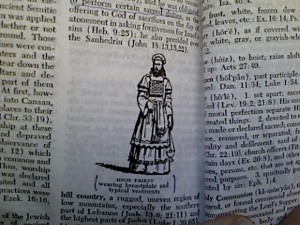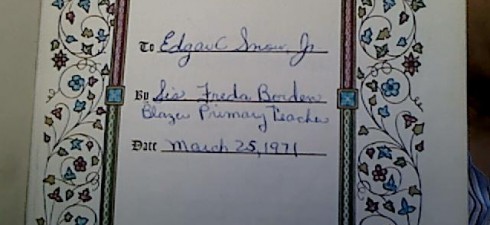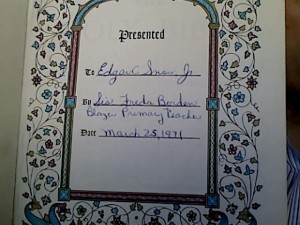Today, we’re lucky to have a guest post from Ed S.
Forty years ago today I received a gift, an item I’ve owned longer, and used more often, than any other possession: a King James Bible (KJV). Originally I thought in this post I would explore, on the eve of its 400th year anniversary, the status of the KJV (aka “The Authorized Version”) in the western literary tradition, or its place in Mormon scripture and thought. But when I recently opened this beloved edition of the KJV that my Blazer Primary teacher gave me so long ago, and flipped through its pages, I was caught up in a reverie of this book’s many journeys with me and my many journeys through its multi-colored passages I’ve underlined and annotated over the years.
I used it in early morning seminary, in particular during scripture chase contests, those verses being underlined in yellow. My technique was to hold the bible spine in the palm of my left hand and blow lightly into the pages, separating them slightly, but without technically opening it, my right index finger poised against the fluttering pages, awaiting a clue, ready to plunge inside to the correct passage and hoist the book high into the air. It is a credit to the bookbinder’s art that my bible survived such irreverent treatment. Our Old Testament seminary instructor loved Proverbs, I remember his favorite being 17:18, a scripture chase passage: “Pride goeth before destruction, and an haughty spirit before a fall.” Another passage he quoted often, underlined by me in red to distinguish it from official scripture chase verses, was 25:24: “It is better to dwell in the corner of the housetop, than with a brawling woman and in a wide house.”
I also used my KJV while dating in the bible belt in the 70s as a . . . prophylactic device. While some might believe the bible provides wonderful birth control protection as an arousal antidote, I used it as protection against the theological “attacks” of the many Southern Baptists I dated. Because I graduated from Primary before the official LDS KJV was produced, I had received from my teacher a bible published by Baptists, complete with a section titled “Bible Study Helps” written by no less than seven biblical scholars, four of which were professors at The Southwestern Baptist Theological Seminary. Oddly enough, their names and seminaries were underlined by me as well, my favorite scholar being a certain Virtus E. Gideon, Th.D.
 These Baptist scholars often came to my aid during the inevitable theological discussions following a typical dinner and a movie. For instance, whenever my date predictably argued that the bible was inerrant, I turned to page 9 of the “Bible Study Helps” where the following passage was underlined in red, resting my case:
These Baptist scholars often came to my aid during the inevitable theological discussions following a typical dinner and a movie. For instance, whenever my date predictably argued that the bible was inerrant, I turned to page 9 of the “Bible Study Helps” where the following passage was underlined in red, resting my case:
“Since the original autograph of no book in the New Testament is known, it becomes the task of the textual expert to deal with the thousands [which word I read, Carl Sagan-like, with gusto and flair] of variant readings to be found in this multitude of ancient manuscripts. These manuscripts are compared and studied in order to establish a critical text that gives reasonable [Carl Sagan voice again] assurance of being as near to the original as can be determined.”
My Primary bible travelled with me on my mission to Germany and Switzerland as well. Although I toted a German bible translation tracting by day, in the morning and evenings I studied my KJV, filling it to the brim with notes gleaned from Bruce R. McConkie’s  New Testament Commentary, Eldin Ricks’ Ready Reference and James Talmage’s Jesus the Christ and The Articles of Faith. While reading in the Bible Dictionary in the Bible Helps section produced by my Baptist theologian friends, I can still remember being struck by the entry about the Old Testament high priest who wore “vestments appropriate to his high office,” his “anointment” and that “he was obligated to perform certain sacred duties.” When I looked at the following artist’s rendering of a high priest accompanying the definition, fully outfitted in temple clothing, I sat slack-jawed, not sure how I might ever communicate to any of my Baptist friends what I considered to be their own scholars’ corroboration of a small portion of the LDS temple experience:
New Testament Commentary, Eldin Ricks’ Ready Reference and James Talmage’s Jesus the Christ and The Articles of Faith. While reading in the Bible Dictionary in the Bible Helps section produced by my Baptist theologian friends, I can still remember being struck by the entry about the Old Testament high priest who wore “vestments appropriate to his high office,” his “anointment” and that “he was obligated to perform certain sacred duties.” When I looked at the following artist’s rendering of a high priest accompanying the definition, fully outfitted in temple clothing, I sat slack-jawed, not sure how I might ever communicate to any of my Baptist friends what I considered to be their own scholars’ corroboration of a small portion of the LDS temple experience:
After my mission, I used my KJV at church and in my Old Testament, New Testament, Isaiah and The Bible as Literature classes at BYU. Numerous handwritten items in black and blue ink were inscribed by me in this period, including the following lecture notes on a blank page before Genesis that I had written down in Steve Walker’s bible lit class:
Biblical Style
* Non-didactic, philosophical–shows, not tells–no editorials
* Use of “And”
* Diction is open ended
* understatement
* imagistic
* no adjectives
* repetitions
* puns (in Hebrew, missing in English)
* rhythmic cadence
* condensed
While taking this class, for the first time ever, I read the Song of Solomon, feeling guilty at first, but afterwards a steadfast convert. I remember using a modern translation to supplement my reading of Chapter 5 and the eyes of my understanding were opened. And although Joseph Smith indicated in a marginal note to his KJV that the Song of Solomon is not inspired, even he could not resist at least one of its many beautiful Jacobean lines, quoting it three times in the D&C: “and terrible as an army with banners.” [See D&C 5: 14; 105: 31; and 109:73]
My bible has accompanied me also in teaching numerous Sunday school, elder’s quorum and LDS institute classes. I have read the Nativity accounts of Luke and Matthew in my home each Christmas Eve from its pages, accompanying an earnest reenactment of the birth of Jesus by my own children and the children of visiting friends, except for the one year I decided, on a whim, to use a Good News Bible, causing a revolt among the participants and audience members alike. “It just doesn’t sound right,” complained one of our neighbors, someone used to hearing Linus recite from memory the King James translation of Luke Chapter 2 in “A Charlie Brown Christmas,” accustomed to hearing his familiar intonations, especially in lines like: “and they were sore afraid.”
So, today I will hold aloft my treasured copy of the King James translation of the Holy Bible, my finger placed on the frontispiece across from an inscription by Sister Borden, my Blazer teacher, to me, which reads: “Always remember the things you’ve been taught and you will truly be happy, Sis Borden.”
She was correct. Like the widow’s cruse of oil blessed by Elijah’s hand to never run dry, reminiscing over what my King James bible has taught me never fails to bring pleasure, comfort and happiness. Sister Borden, thanks again.


Oh, Ed, this was very touching. I loved reading this. Makes me want to dig up my first scriptures.
Ed, do you know whether Sister Borden still living? I bet she would have loved to read this.
I’m thinking back now to the different sets of scriptures that we had in our home growing up.
I’ve suddenly remembered a white Holy Bible with a zip-up cover and a cross hanging off the zipper. Inside, all of the words uttered by Jesus were printed in red, which I thought was kind of neat as a kid. There was also a family tree section in the first pages. I’m not sure what became of that Bible, or where it came from, but I assume it was from my father’s pre-Mormon, United Church of Canada days.
When I was in grade 5 and it was still allowed, I received a little red copy of the New Testament when the Gideons came to my class to hand them out. I bet it’s still on my old bookshelf at my parents’ home in Canada. The worry-wart Type A personality that I was, I remember that I was fond of a section at the back of the book with a quick reference guide to different verses, depending on how you were feeling: joyful, sad, afraid, thankful, etc. I remember some anxious nights as a young teenager, especially when I first started to notice symptoms of what turned out to be a minor heart arrhythmia, I would flip to that section and look for reassurance that I would wake up the next morning.
Years later when I made my first trips alone overseas, I was nervous about flying and would always pack a Book of Mormon in my hand luggage. It was a lot lighter than dragging my quad with me, and although I don’t think I ever actually opened it during any flights, I always felt a bit of reassurance that I’d have a safe flight simply because I had it with me.
I’ve never been an avid scripture reader, I must admit. But I do have to credit reading the Book of Mormon in helping me learn French, German and Norwegian. It was hard to find a book that I was already familiar with in each of these languages for free, and they were all hard cover to boot. So I killed three birds with one stone by “following the prophet” plus my French and German teachers.
Heather and FD, thanks for the kind thoughts.
FD, I heard that Sis Borden died last year, but I was able to tell her about 11 years ago that I still had the bible she had given me, which pleased her. Learning languages through the BoM would make it easier–excellent idea. And, as you note, many times these books are more than texts and they are really something like … Linus’s blanket, I guess.
Ed, I love this too. I don’t have any particularly special copies of the scriptures, but I did dearly love my New Testament that we got in Primary, and the sharp red pencil that came with it. We made tote bags for them, and mine was black vinyl, with red and yellow stripes, in the spirit of the times (1968).
I love that this post captures how personal our relationship is with the scriptures. Our usage is so connected to time and place, the people we interact with, the people we are in each phase of our lives. When I started to understand scriptures in a more literary (and less literal) way, it opened up a whole new world to me, they became like poetry, like music.
But it is also significant to connect with a concrete object, the thing that you hold in your hand, that has traveled through so much time with you. The set I recieved on my 13th birthday had pages that had been damaged when my tent was flooded at girl’s camp (most of Genesis, really), It was full of notes and marks — the verses I had memorized in seminary, underlined at BYU, found on my own. Quotes I had written in the margins. There were the pages that were torn by my daughter — when she was about 18 months, I came upon her one afternoon, gleefully tearing the tissue thin paper out of the book. My scriptures went missing shortly before we moved to England. I searched everywhere, but, in the end, I made the trip without them.
Yes, as you’ve all noted, the scriptures are not merely a text, but can also be a curated artifact in an intellectual museum, a family heirloom, a personal talisman and a spiritual scrapbook.
Sorry I couldn’t comment on the day this ran. I loved the memories, especially the Bible Belt trickery. :) The pictures were wonderful too – your handwritten signature is very sweet and captures something significant, I think. I appreciate the memories you shared.
It’s good to hear of your love for your Bible =) I love mine too.
Want to have a cool reading experience and know Heavenly Father and Jesus Christ more and more? try reading through the New testament like a child. I guarantee if you read it with a child’s eyes and heart you will learn so much…